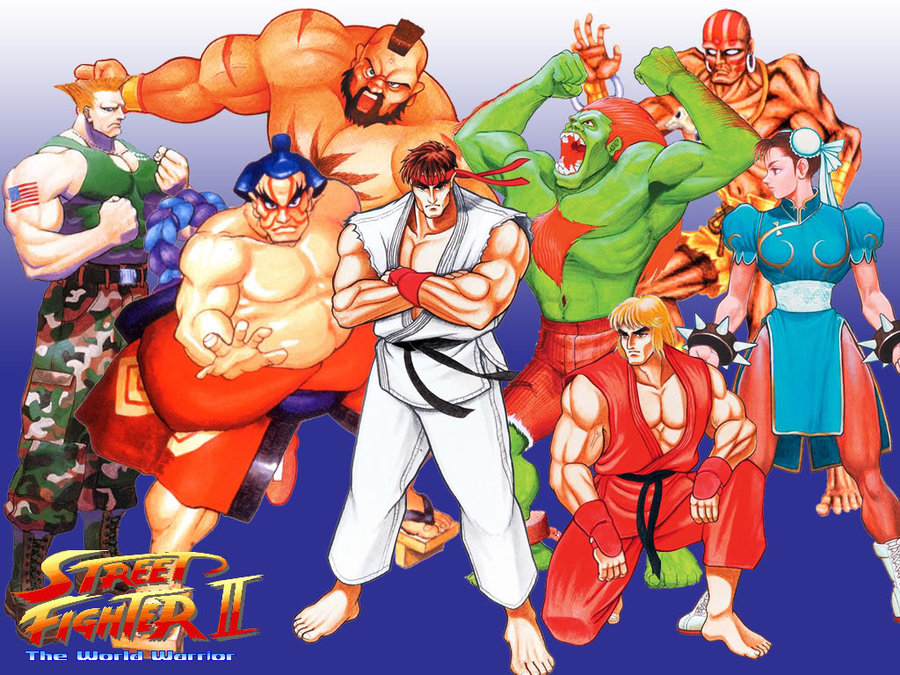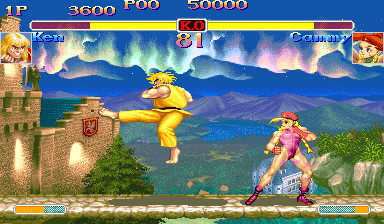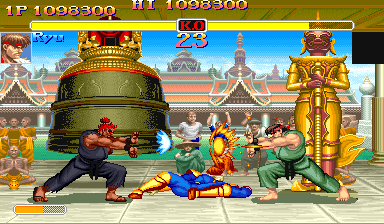
Welcome back to the Street Fighter Legacy, a retrospective series where I’ll be covering each installment in the Street Fighter series and talking about the history of these games as well as my personal thoughts on them. Last episode, I talked about the original Street Fighter game and how it set a blueprint for future fighting games due to its introduction of special attacks, even if the game itself was frustrating to play with and it doesn’t hold up by today’s standards. Today, I will be covering the sequel Street Fighter II, released in 1991, which is considered to be one of the greatest video games of all time and helped usher in the popularity of the fighting game genre in the 1990s, inspiring other fighters such as Fatal Fury, Mortal Kombat & Killer Instinct.
Before we talk about Street Fighter II, let’s head back to the late 80s for a bit. On August 30th, 1987, the original Street Fighter came out and became a modest success. Originally, it came with an arcade machine featuring two punching-pads, but it wasn’t very successful. However, the six button arcade cabinet of Street Fighter was more successful, which made Capcom interesed in making a sequel, even if some of the developers who were working on the first game were going to return. Takashi Nishiyama, the director and co-creator of the original Street Fighter, would leave Capcom following that game and would end up working with SNK, creating games such as Fatal Fury & Art of Fighting as well as being co-producer of The King of Fighters series.

In 1988, months after Nishiyama’s departure, Capcom began working on a concept for Street Fighter II. The original concept for the game was removing all of the characters from the original game and introducing eight brand new characters as well as having the game being set on an island, where the player participates in a tournament and makes his way through the island, eventually reaching the top of the mountain to challenge the final boss. However, plans for the sequel were scrapped once Capcom noticed the success of Double Dragon II: The Revenge in Japan and decided to capitalize on the success of the beat-em-up genre.
The team behind the creator of the new game was led by designer Akira Nishitani and composed of fellow colleagues Yoshiki Okamoto, Noritaka Funamizu & Akira Yasuda. Around the same time as the original Street Fighter‘s release, Nishitani’s team worked on Forgotten Worlds, a side-scrolling shooter set in the 29th Century for the CP System. Inspired by Double Dragon‘s success, Okamoto decided to make a beat-em-up game focusing on three characters going through the streets of Metro City and fighting against the Mad Gear gang and it was the moment Okamoto was persuaded by Capcom’s sales division unit to call the game “Street Fighter“, as they were desperate for a new “Street Fighter” game.

When the game was being promoted around the world as Street Fighter ’89, people were confused about it, as it played and looked nothing like the first game and wondered why was the game was called Street Fighter. Because of the reception, Capcom decided to change the name to Final Fight, which would become an arcade success in 1989 and kicked off the Final Fight series, which shares the same universe as the Street Fighter series and had several of its characters move over to Street Fighter later down the road. Following the success of Final Fight in the US, Capcom decided to make the sequel to Street Fighter a priority and added the development team of Final Fight to work on Street Fighter II, hoping to recapture the success of that game onto the sequel.
In an interview for GamePro Magazine in 1994, Okamoto said: “The Basic idea at Capcom was to revive Street Fighter, a good game in concept, but to make it a better game.” Development on Street Fighter II would take two years, with the intent on improving certain aspects from the first game and make it a more playable game. Around 34 to 35 people were brought on board to develop the game, including Okamoto, Funamizu, Nishitani & Yasuda, around an estimated budget of $2,450,000. Funamizu was in charge as the producer, while Nishitani & Yasuda were in charge of game and art design, respectively. At some point during development, the development team planned on bringing Ken back as the only character from the original game, before deciding to add Ryu as well. Eventually, after ten months of development, Street Fighter II was released on March 7th, 1991 and it would become a huge success at the arcades and becoming the best-selling game at Capcom (until 2007), giving birth of the fighting game boom of the ’90s.

One of the main draws of Street Fighter II was the combat, as the the game takes the 1-on-1 combat from the original game and refines it, as it’s no longer about pulling out special moves quickly, but rather, it allows the player to use their skills and find a way to defeat the opponent. It also introduces combos, which became the standard for all fighting games in the future, and makes the player feel like they were actually fighting the opponent. Originally, the combo system was a glitch, as Funamizu was making a bug check during the car stage and decided to keep it as a hidden feature players could unlock.
The visual presentation is also improved from the first game, as Street Fighter II was running on the CPS-1 System, allowing the game to stand out more on a visual scale and bringing the world of Street Fighter II to life. The sprites were now able to move, the stages are more vibrant than ever and the characters have more personality to their poses. The music was composed by legendary composer, Yoko Shimomura, whose theme music for this game would become synonymous with the franchise going forward, such as Ken’s theme, Ryu’s theme or Guile’s theme.

Street Fighter II features 8 playable characters, all coming from different backgrounds with unique move sets and personalities, giving the player many options of picking a character that fit their playstyle. There was Ryu and Ken from the original game, but new additions to the cast were Interpol agent Chun-Li, military operative Guile, Russian wrestler Zangief, Brazilian beast-man Blanka, Yoga master Dhalsim and sumo wrestler E. Honda. This roster would go on to represent the franchise in the future and would become pop culture stables. The arcade ladder consists of 7 fights, where the player travels around the world and fights 7 of the 8 playable characters, before fighting 3 different mid-bosses, Balrog, Vega and Sagat, to reach the final boss and host of the tournament, M. Bison.
I’ll admit, out of the 3 mid-bosses, Sagat is probably the most difficult mid-boss, as he is just as annoying to beat as he was in the original game, while Balrog is the easiest one. M. Bison himself isn’t that tough, as you can beat him easily in this game, though he’s still very challenging. The biggest problem I encountered during the arcade ladder was the infuriating AI as it can make the experience frustrating and impossible to beat. Throughout the arcade ladder, the player would go through three mini-games, similar to the first game; smashing the car, destroying 20 wooden barrels and breaking metal oil drums. Out of all the three mini-games, I found the metal oil drum mini-game to be the easiest one while the wooden barrel mini-game to be the difficult one.

Deciding to capitalize on the success of Street Fighter II, Capcom released four more updates between 1992 and 1994; Championship Edition in early 1992, which made the bosses playable, Hyper Fighting in late 1992, which was inspired by the hacked version of the game called Rainbow Edition and enhanced the speed, The New Challengers in 1993, which introduced four new characters: Cammy, Fei Long, Dee Jay and T. Hawk & Super Turbo in 1994, which introduced the mysterious fighter, Akuma, who can be fought in the arcade ladder if the player achieves a high score, but it doesn’t stop there, there was also Hyper Street Fighter II for the Playstation 2 in 2003 and the HD remake Super Street Fighter II HD Remix for the Playstation 3 in 2008, which featured newly drawn graphics by comic book company UDON.
Without a doubt, Street Fighter II is the definition of a perfect video game sequel; Not only did it manage to eclipse the original in terms of popularity, it had also influenced several fighting game franchises, such as the King of Fighters and Mortal Kombat, as well as 3D entries such as Virtua Fighter and Tekken. Without Street Fighter II, the Fighting Game Community would not be the same. Next episode of the legacy, I will be taking a look at Street Fighter Alpha and its sequels.